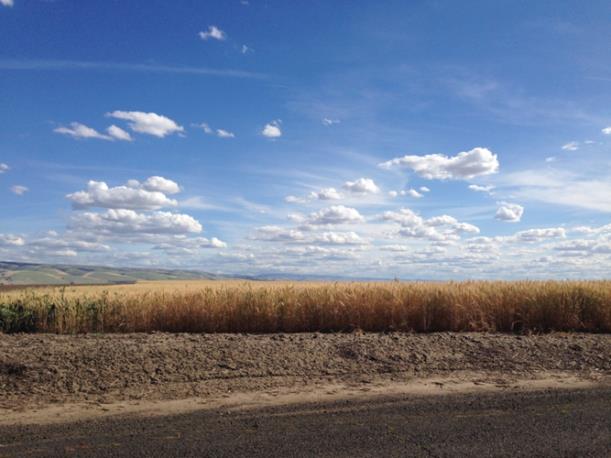Climate change is among the greatest challenges facing 21st century agriculture. To anticipate those challenges a cutting-edge Northwest scientific exploration is bringing some very 21st century tools to bear.
Regional Approaches to Climate Change (REACCH) is one of the largest such projects ever mounted. The $20-million, five-year effort funded by the USDA National Institute on Food and Agriculture focuses its efforts on one of the world’s great grain growing regions, the inland Northwest.
The effort is an important trans-disciplinary research model. It joins researchers from three land-grant research universities, University of Idaho, Washington State University and Oregon State University, and the USDA Agricultural Research Service (ARS). They represent 51 disciplines working on 15 projects. The effort will soon mount its own website. For now go here.
REACCH asks two critical questions: How can farming in the region become more economically and environmentally sustainable under anticipated climate changes? How can farming help stem climate change by reducing and soaking greenhouse gas emissions?
One reason this is cutting edge is because it unifies strategies to cope with global warming and reduce it. With climate change intensifying, these two approaches are going to increasingly have to come together under one roof. The Northwest Biocarbon Initiative www.nwbiocarbon.org is focusing on farming along with forestry and urban development -- areas where adaptation and mitigation actions readily join.
REACCH held its first year conference in Pendleton Feb. 29-March 1. This short blog post cannot do justice to the richness of work underway. But it was a bold underscore on the way 21st century data tools are helping us prepare for climate change. For example, remote sensing data from satellites is driving models that can help farmers make crop rotation decisions.
One example illustrates the importance of the work. ARS soil scientist Dave Huggins presented modeling that will enable scientists and farmers to track and project changes in growing regions over time. The Inland Northwest has very distinct agroecological zones conditioned by precipitation and soil types. As moisture shifts, farmers will need to change cropping patterns. The new model provides a means to plan for change.
“REACCH is actionable science,” noted Principal Investigator Sanford Eigenbrode, a University of Idaho entomologist.
Jim Peterson, an advisor to the project, who works for LIMAGRAIN, a cereal seed breeder, nailed how crucial it is to peer into the climate future. He noted that one form of rust disease affecting wheat in cooler climates could well be replaced by another that thrives in warmer climates. It will take 10-15 years to breed the germplasm needed for Northwest crops that resist the warm weather rust, Peterson said. So good climate projections are needed.
Another advisor, Idaho farmer Richard Wittman, noted, “We are reacting to more changes than we ever have. As we get more shocks, particularly climate, how will we change our cropping plans?”
REACCH also embodies emission reductions. For instance, precision nitrogen fertilizer applications reduce emissions of nitrous oxide, a greenhouse gas 320 times more powerful than carbon dioxide. This also makes farming more economically sustainable by reducing costly inputs. REACCH also explores carbon sequestration - how reducing and eliminating tillage can lock up carbon in the soil.
I am also an advisor to the project, a member of the Stakeholder Advisory Committee (SAC) along with a group representing the diversity of interests engaged in agriculture – farmers, farm organizations, farm service companies, educators, etc. I had the honor of being one of five SAC members on a panel addressing what we need from REACCH. Here is a paraphrase of what I told the group.
For farming to be ecologically sustainable it must be economically sustainable. So we need to know how to draw together the business case and the environmental case. We seek to make farmers providers of ecological services, rewarded as they would for any other crop they grow. The big three are water supply and quality, carbon storage and wildlife. Typically practices that provide one supply all three.
We therefore need to understand practices that optimize carbon and nitrogen flows in farming. We need to know how to economically reduce nitrous oxide emissions while putting more carbon back in the soil. Especially important in that regard is developing systems to economically return organic nutrients to the soil from sources such as urban and industrial organic residue streams.
We also need low-cost measurement and modeling tools to quantify ecological service benefits such as carbon accumulation. Currently the cost and complexity of validating increases in soil carbon discourages participation in emerging carbon markets. We need to make this easier.
We need better understanding of prospective bioenergy feedstocks. For example, what is holding back mass cultivation of oilseeds such as camelina? Can we develop better varieties that reduce risks for farmers?
Finally, we need to understand the implications of changing climate for agriculture to provide ecological services and bioenergy feedstocks. Will farmers be able to provide more, or less?
Ultimately we expect climate legislation to return to the U.S. Congress in coming years. When that happens, we hope that support for farmers to sequester carbon will be in the foreground. We need direct support for carbon sequestration apart from offsets which only balance against current emissions. We need to begin to actively reduce carbon in the atmosphere, and soaking it in the land through improved farming practices is one of our greatest opportunities to do so.
When climate legislation returns we hope the farming community will see its opportunity as an ecological services provider. It is our aim at Northwest Biocarbon Initiative to help make this happen.





